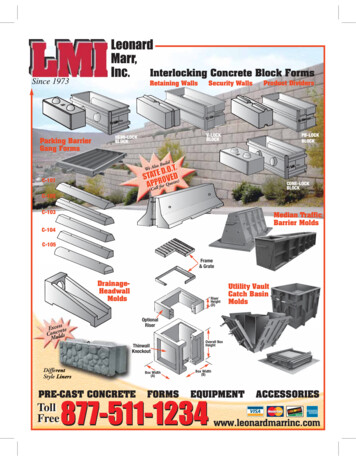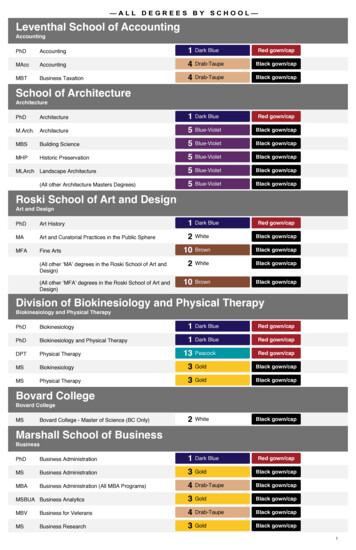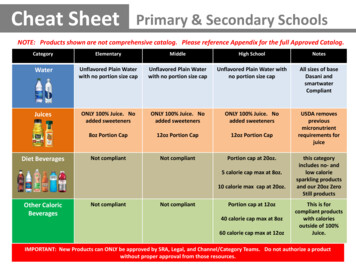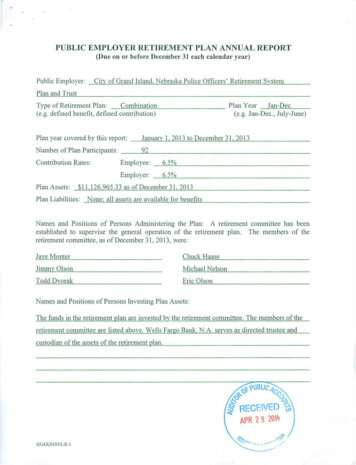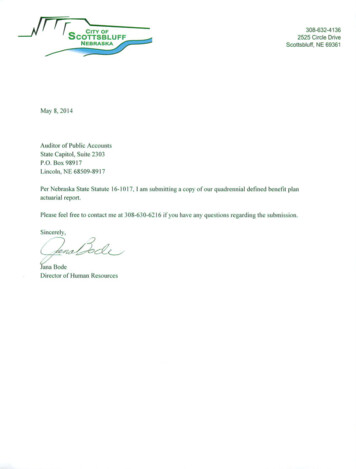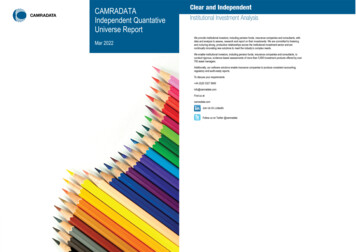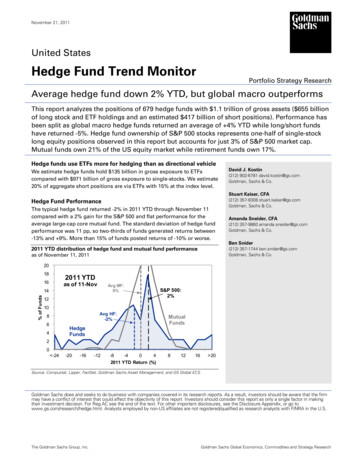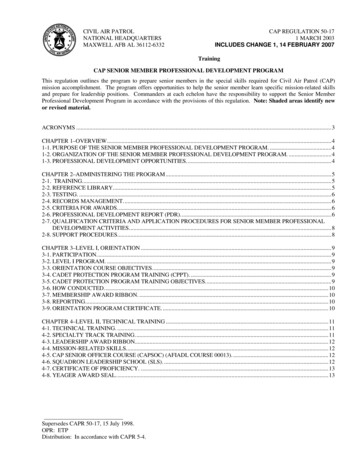
Transcription
CIVIL AIR PATROLNATIONAL HEADQUARTERSMAXWELL AFB AL 36112-6332CAP REGULATION 50-171 MARCH 2003INCLUDES CHANGE 1, 14 FEBRUARY 2007TrainingCAP SENIOR MEMBER PROFESSIONAL DEVELOPMENT PROGRAMThis regulation outlines the program to prepare senior members in the special skills required for Civil Air Patrol (CAP)mission accomplishment. The program offers opportunities to help the senior member learn specific mission-related skillsand prepare for leadership positions. Commanders at each echelon have the responsibility to support the Senior MemberProfessional Development Program in accordance with the provisions of this regulation. Note: Shaded areas identify newor revised material.ACRONYMS .3CHAPTER 1–OVERVIEW.41-1. PURPOSE OF THE SENIOR MEMBER PROFESSIONAL DEVELOPMENT PROGRAM. .41-2. ORGANIZATION OF THE SENIOR MEMBER PROFESSIONAL DEVELOPMENT PROGRAM. .41-3. PROFESSIONAL DEVELOPMENT OPPORTUNITIES.4CHAPTER 2–ADMINISTERING THE PROGRAM .52-1. TRAINING.52-2. REFERENCE LIBRARY.52-3. TESTING. .62-4. RECORDS MANAGEMENT.62-5. CRITERIA FOR AWARDS.62-6. PROFESSIONAL DEVELOPMENT REPORT (PDR).62-7. QUALIFICATION CRITERIA AND APPLICATION PROCEDURES FOR SENIOR MEMBER PROFESSIONALDEVELOPMENT ACTIVITIES.82-8. SUPPORT PROCEDURES.8CHAPTER 3–LEVEL I, ORIENTATION .93-1. PARTICIPATION.93-2. LEVEL I PROGRAM. .93-3. ORIENTATION COURSE OBJECTIVES.93-4. CADET PROTECTION PROGRAM TRAINING (CPPT). .93-5. CADET PROTECTION PROGRAM TRAINING OBJECTIVES.93-6. HOW CONDUCTED.103-7. MEMBERSHIP AWARD RIBBON. .103-8. REPORTING.103-9. ORIENTATION PROGRAM CERTIFICATE. .10CHAPTER 4–LEVEL II, TECHNICAL TRAINING .114-1. TECHNICAL TRAINING. .114-2. SPECIALTY TRACK TRAINING.114-3. LEADERSHIP AWARD RIBBON.124-4. MISSION-RELATED SKILLS.124-5. CAP SENIOR OFFICER COURSE (CAPSOC) (AFIADL COURSE 00013). .124-6. SQUADRON LEADERSHIP SCHOOL (SLS). .124-7. CERTIFICATE OF PROFICIENCY. .134-8. YEAGER AWARD SEAL. 13Supersedes CAPR 50-17, 15 July 1998.OPR: ETPDistribution: In accordance with CAPR 5-4.
2CAPR 50-17 (C1) 14 FEBRUARY 2007CHAPTER 5–LEVEL III, MANAGEMENT .145-1. MANAGEMENT. .145-2. BRONZE STAR FOR LEADERSHIP RIBBON. .145-3. CORPORATE LEARNING COURSE (CLC). .145-4. GROVER LOENING AEROSPACE AWARD. .15CHAPTER 6–LEVEL IV, COMMAND AND STAFF.166-1. COMMAND AND STAFF. .166-2. SILVER STAR FOR LEADERSHIP RIBBON. .166-3. REGION STAFF COLLEGE (RSC). .166-4. PAUL E. GARBER AWARD .186-5. NATIONAL LEGAL OFFICERS’ COLLEGE.186-6. CAP INSPECTOR GENERAL COLLEGE. .186-7. CHAPLAIN SERVICE REGION STAFF COLLEGE.18CHAPTER 7–LEVEL V, EXECUTIVE.207-1. EXECUTIVE.207-2. NATIONAL STAFF COLLEGE (NSC). .207-3. GILL ROBB WILSON AWARD.207-4. SUGGESTED WILSON AWARD CITATION.21CHAPTER 8–AIR FORCE INSTITUTE FOR ADVANCED DISTRIBUTED LEARNING .228-1. AIR FORCE INSTITUTE FOR ADVANCED DISTRIBUTED LEARNING (AFIADL).228-2. AFIADL FORMS. .23CHAPTER 9–SPECIAL RECOGNITION PROGRAMS .249-1. SPECIAL RECOGNITION PROGRAMS FOR PRIOR CADETS (REF ATTACHED CAP/CC ICL, 4 JUN 08). .249-2. SPECIAL RECOGNITION PROGRAMS FOR LEGAL OFFICERS.24ATTACHMENT 1–CAP SENIOR MEMBER PROFESSIONAL DEVELOPMENT PROGRAM PROGRESSION ANDAWARDS.25ATTACHMENT 2–MILITARY EDUCATION QUALIFYING AS EQUIVALENT TO CAP SENIOR OFFICER COURSE,REGION STAFF COLLEGE AND NATIONAL STAFF COLLEGE .26ATTACHMENT 3–CAPF 45, SENIOR MEMBER MASTER RECORD .27ATTACHMENT 4–CAPF 45B, SENIOR MEMBER PROFESSIONAL DEVELOPMENT RECORD .31ATTACHMENT 5–PROFESSIONAL DEVELOPMENT REPORT .33ATTACHMENT 6–CAPF 11, CAP SENIOR MEMBER PROFESSIONAL DEVELOPMENT PROGRAM DIRECTOR'SREPORT.34ATTACHMENT 7 –CAPF 24, APPLICATION FOR SENIOR MEMBER PROFESSIONAL DEVELOPMENT AWARDS.36ATTACHMENT 8 –CAPF 17, APPLICATION FOR SENIOR MEMBER ACTIVITIES .38ATTACHMENT 9–CAPF 2A, REQUEST FOR AND APPROVAL OF PERSONNEL ACTIONS.40ATTACHMENT 10–CAPF 8, REQUISITION FOR PUBLICATIONS AND BLANK FORMS.41ATTACHMENT 11–CAPF 46, CAP PROFESSIONAL DEVELOPMENT COURSE MATERIALS ORDER FORM .42ATTACHMENT 12–MAXWELL AFB FORM 117, ACSC DISTANCE LEARNING PROGRAM APPLICATION.43ATTACHMENT 13A–SAMPLE AFIADL FORM 23, AFIADL ENROLLMENT APPLICATION .44ATTACHMENT 13B– INSTRUCTIONS FOR COMPLETING AFIADL FORM 23.44ATTACHMENT 13C–FAX FOR AFIADL FORM 23, ENROLLMENT PROCEDURES .45ATTACHMENT 13D–AFIADL FORM 17, STUDENT REQUEST FOR ASSISTANCE.46ATTACHMENT 14 – DIRECTOR/STAFF DUTY OPPORTUNITIES (REF ATTACHED CAP/CC ICL, 30 JUL 08) .48NOTE: AFIADL FORMS WILL CONTINUE TO USE THE ECI DESIGNATION UNTIL STOCKS AREEXHAUSTED.
CAPR 50-17 1 MARCH 20033ACRONYMSACSC--Air Command and Staff CollegeAFIADL--Air Force Institute for Advanced DistributedLearningAWC--Air War CollegeCAP--Civil Air PatrolCAPF--Civil Air Patrol FormCAPIGC--Civil Air Patrol Inspector General CollegeCAPM--Civil Air Patrol ManualCAPSOC--Civil Air Patrol Senior Officer Course(AFIADL Course 13)NCASE--National Congress on Aviation and SpaceEducationNHQ CAP/PD--National Headquarters Civil Air PatrolChief, Professional DevelopmentNLOC--National Legal Officers’ CollegeNSC--National Staff CollegePAO--Public Affairs OfficerPD--Professional DevelopmentPDO--Professional Development Officer (Unit)PDR--Professional Development ReportCAPP--Civil Air Patrol PamphletPME--Professional Military EducationCAPR--Civil Air Patrol RegulationRSC--Region Staff CollegeCE--Course ExaminationSAR--Search and RescueCLC--Corporate Learning CourseSFO--Senior Flight OfficerCOP--Certificate of ProficiencySLS--Squadron Leadership SchoolCPPT--Cadet Protection Program TrainingSOS--Squadron Officer SchoolCSRSC--Chaplain Service Region Staff CollegeTCO--Test Control OfficerDCS/PD-- Deputy Chief of Staff for ProfessionalTFO--Technical Flight OfficerDevelopment (Region)DPD--Director of Professional Development (Wing)FAA--Federal Aviation AdministrationFEMA--Federal Emergency Management AgencyFO--Flight OfficerHC--ChaplainIACE--International Air Cadet ExchangeUCC--Unit Commanders CourseUSA--United States ArmyUSAF--United States Air ForceUSCG --United States Coast GuardUSMC--United States Marine CorpsUSN--United States Navy
4CAPR 50-17 1 MARCH 2003CHAPTER 1–OVERVIEW1-1. Purpose of the Senior Member Professional Development Program.CAP is a federally chartered non-profit corporation. It is the official auxiliary of the United States Air Force. Congresschartered CAP to perform certain duties for individual communities and for the nation. That charter helped establish CAP’sthree missions: Emergency Services, Aerospace Education, and Cadet Programs. To accomplish its mission, CAP requiresan informed, active senior membership trained in leadership, management, and functional tasks. The CAP Senior MemberProfessional Development Program prepares members to serve their units, their communities, and their nation.1-2. Organization of the Senior Member Professional Development Program.Five levels comprise the Senior Member Professional Development Program. Each level is briefly explained below. (Alsosee Attachment 1, CAP Senior Member Professional Development Program Progression and Awards chart.)a. Level I, Orientation. Level I training provides the new senior member with information required for activemembership in CAP. This level consists of the Orientation Course and Cadet Protection Program Training (CPPT). Shortlyafter joining CAP, the member receives a collection of pamphlets and manuals from the CAP Bookstore that make up thesenior member handbook. Members should study these materials prior to attending a Level I Orientation Course. The LevelI Orientation Course provides basic information about the CAP program. It consists of video and instructor presentations.Chapter 3 details Level I training.b. Level II, Technical Training. In this level, the member acquires a technical skill and begins receiving basictraining in leadership and management topics. CAP presents study material in pamphlets called Specialty Track StudyGuides. Each member, in coordination with the unit commander and unit Professional Development Officer (PDO), selects aspecialty based on individual interests and the needs of the unit. Squadron Leadership School (SLS), a formal course, trainssquadron-level members to perform their squadron jobs and introduces leadership and management techniques. Level IItraining also includes the Air Force Institute for Advanced Distributed Learning (AFIADL) CAP Senior Officer Course.CAP requires completion of Level II and time-in-grade for duty performance promotion to the grade of captain. Chapter 4gives the specific details of Level II training.c. Level III, Management. Senior members desiring to serve in CAP management positions train at this level.Completion of Level III requires attending a Corporate Learning Course (CLC) and other specialized requirements. CAPrequires completion of Level III and time-in-grade for duty performance promotion to the grade of major. Chapter 5 givesspecific details of the Level III program.d. Level IV, Command and Staff. This level concentrates on members desiring to become leaders in CAP. Everywing and region commander, and those members being groomed to replace them, should complete Level IV. CAP requiresmembers to complete Region Staff College (RSC) at this level. Members unable to attend a region staff college maycomplete the USAF Squadron Officer School (SOS) by correspondence or any of the Professional Military Education (PME)equivalents in Attachment 2. In order to receive a duty performance promotion to the grade of lieutenant colonel, membersmust complete Level IV and time-in-grade. Chapter 6 gives the specific details of the Level IV program.e. Level V, Executive. Those performing duty as commanders or staff officers train at this level. This levelconcentrates on advanced leadership and management subjects. To complete this level, members attend the National StaffCollege (NSC). Members unable to attend the college may elect to complete the USAF Air Command and Staff College(ACSC) by correspondence or any of the PME equivalents in Attachment 2. Chapter 7 gives the specific details of the LevelV program.NOTE: CAP requires members to earn the awards accompanying the various levels of professional development prior tobeing recommended for duty performance promotions. See CAPR 35-5, CAP Officer and Noncommissioned OfficerAppointments and Promotions, for criteria for special and professional appointments and promotions based on education ormission related skills.1-3. Professional Development Opportunities.CAP offers numerous senior member professional development opportunities. These include the Air Force Institute forAdvanced Distributed Learning as well as CAP resident courses. Each year the Civil Air Patrol News lists nationalprofessional development opportunities. Professional Development Officers should give this annual list the widest possiblepublicity by reviewing it at unit meetings and posting it on the unit bulletin board and encouraging members to attend theseactivities.
CAPR 50-17 1 MARCH 20035CHAPTER 2–ADMINISTERING THE PROGRAM2-1.Training.a. CAP provides numerous senior member training activities. Some, such as the NSC in Level V, directly relate to theSenior Member Professional Development Program. Others, such as emergency services training, develop individual skillsthat aid CAP in accomplishing its overall mission. All activities supplement and expand upon the formal ProfessionalDevelopment Program and offer members an opportunity to meet other members with mutual interests. Each unit isresponsible for ensuring the quality of the training it conducts. In addition, each echelon (NHQ CAP, region, wing, group,etc.) is responsible for monitoring the quality of training within its areas of responsibility, to ensure students have the bestlearning experiences possible. Quality in this context is defined as:1) The comprehension of course material by students when measured against the objectives for the course.2) Thoroughness of course preparation by the course director and staff.3) The effectiveness of instruction when measured against the learning objectives and teaching instructions.4) Compliance with CAP directives and course guidelines, i.e., instructions for course administration.b. Training opportunities include:1) Inland Search and Rescue Course. The USAF conducts this course periodically throughout the year. Thecurriculum includes all aspects of organization, planning, communications, and operations involving inland search and rescue(SAR). CAP reserves this course for incident commanders/agency liaisons and potential incident commanders/agencyliaisons actively involved in unit SAR activities. It is a 5-day course.2) Flight clinics.3) Air Force Rescue Coordination Center CAP SAR Management Course (generally one per year in each region).4) State-held Federal Emergency Management Agency (FEMA) Staff College.5) Air Force Institute for Advanced Distributed Learning:a) CAP Senior Officer Course (CAPSOC)b) Squadron Officer School (SOS)c) Air Command and Staff College (ACSC)d) Air War College (AWC)6) Specialized technical courses (through AFIADL).7) Regional emergency services training.8) Survival courses (winter and summer).9) Various regions’ schools.10) Scholarships. CAP provides scholarship opportunities for senior members working on undergraduate, graduate,and vocational-technical programs. See CAPR 52-16, CAP Cadet Training Program, for complete details.c. The Civil Air Patrol News announces national-level events to all units. It outlines the programs available andcriteria for attendance. Regions responsible for certain programs announce region-level and wing-level training by letter.Region and wing public affairs officers (PAOs) also publicize such programs.d. Application procedures and deadlines for application processing are described in paragraph 2-7. Events that requiresupport by USAF airlift require much longer lead times to coordinate requests through CAP-USAF channels.2-2. Reference Library.CAP Professional Development Officers should maintain a library of materials used in the Senior Member ProfessionalDevelopment Program. This library should be kept current and maintained separately from the administrative files. Contentsshould include professional development-oriented material. As a minimum, it should contain CAPP 8, Test Control OfficerGuide to Air Force Institute for Advanced Distributed Learning; CAPR 50-17; CAPR 35-5, CAP Officer andNoncommissioned Officer Appointments and Promotions; CAPR 39-3, Award of CAP Medals, Ribbons, and Certificates; andCAPR 50-4, Test Administration and Security; all senior member specialty track study guides; and the senior memberhandbook. The senior member handbook is sent to all new senior members and is available from the CAP Bookstore. Itincludes CAPM 39-1, CAP Uniform Manual; CAPP 50-5, Introduction to CAP; CAPP 151, Standards, Customs, andCourtesies; NHQ CAP Safety Letter; Senior Member Professional Development Diagram; and CAPP 50-6, Cadet ProtectionPolicy and Program for Parents and Leaders. In addition, each wing should have the current Air Force Institute forAdvanced Distributed Learning (AFIADL) Catalog (available only on the Internet at www.au.af.mil/au/afiadl). Other helpfulmaterials include Federal Aviation Administration (FAA) publications pertaining to CAP and training materials from theAmerican Red Cross, Federal Communications Commission, FEMA, and the USAF.
6CAPR 50-17 1 MARCH 20032-3. Testing.CAP does not centrally control testing. CAP administers testing in accordance with CAPR 50-4, Test Administration andSecurity, and the regulation prescribing each test. Each CAP unit commander designates a test control officer (TCO) on aCAPF 53, sending one copy to NHQ CAP/CP, one copy to the wing and keeping a copy on file at the unit. The unit TCOappoints alternate TCOs by letter. TCOs and alternates must be at least 21 years old. Commanders, regardless of their levelof command, cannot serve in the dual capacity of commander and testing officer or alternate. All TCOs handle courseexaminations and test materials according to CAPR 50-4.2-4.Records Management.a. The CAPF 45, Senior Member Master Record (Attachment 3), contains the senior member's master personnelrecord, mission training record, emergency services participation record, and aircrew training/evaluation check record. Theunit personnel officer, with input from the other functional officers, maintains this multipurpose form. However, thepersonnel officer may delegate this duty to other officers. In the case of Senior Member Professional Development records,the personnel officer may delegate this duty to the Professional Development Officer, at the discretion of the unitcommander.b. Members use CAPF 45b, Senior Member Professional Development Record (Attachment 4) for recording progressin the five levels of the Senior Member Professional Development Program. The unit Professional Development Officermaintains this record.c. After units record senior member professional development data, the professional development officer updatesspecialty training tracks on the unit Professional Development Report (PDR) (Attachment 5). To update other data on theProfessional Development Report, members should submit a copy of the respective CAPF 11, Civil Air Patrol SeniorMember Professional Development Program Director’s Report (Attachment 6), or a copy of the course certificate.2-5. Criteria for Awards.Although the administrative management for these awards rests with the National Headquarters Chief of ProfessionalDevelopment, unit commanders ensure that individuals have successfully completed all requirements for an award.a. Awards motivate members.Leaders should present theseawards in a timely manner tostimulate members to furtherattainment. CAP recommends theprocedure (to the right) for ertificate of ProficiencyGrover LoeningPaul E. GarberGill Robb WilsonSquadronSquadronSquadronWingWingSee Chapter 7PRESENTINGOFFICIALUnit CommanderUnit CommanderUnit CommanderWing Cmdr or DesigneeWing Cmdr or DesigneeSee Chapter 7b. Unit commanders have the approval authority for award of the CAP Membership Award, Leadership Award, andthe Certificate of Proficiency.c. Individual members purchase ribbons for the Membership and Leadership Awards from the CAP Bookstore.d. NHQ CAP/PD provides certificates, ribbons, and devices for the remaining awards.e. Members submit applications for awards on CAPF 24, Application for Senior Member Professional DevelopmentAwards (Attachment 7). Documentation (certificates, diplomas, etc.) need not be attached if the Professional DevelopmentReport shows completion of requirements. A member submitting an application for an award whose achievements do notappear on the Professional Development Report must attach copies of supporting documents. NHQ CAP/PD returnsapplications not supported by Professional Development Report entries or documentation.f. The next higher commander in the chain of command approves professional development accomplishments forcommanders.2-6. Professional Development Report (PDR).CAP intends the Professional Development Report (Attachment 5) to serve as a management tool for unit ProfessionalDevelopment Officers, CAP commanders, and for National Headquarters to track and determine training requirements. Thereport lists each CAP unit and reflects the current status of senior members within each unit. The body reflects the member’sstatus in professional development and certain other data maintained in the computer. National Headquarters updates andpublishes the PDR every 2 months. Each unit (region, wing, group, squadron, etc.) receives two copies of their respectivePDR. One copy is retained as a file copy and the unit’s Professional Development Officer returns the other to NHQ CAP/PDfor computerized record updates. If required, higher level Professional Development Officers request PDRs directly fromtheir subordinate units, or download from the CAP web page. DO NOT RETURN THE PDR TO NHQ CAP/PD IFTHERE ARE NO CHANGES TO BE MADE.
CAPR 50-17 1 MARCH 2003a.7General Guidance:1) Only update specialty track data on the PDR.2) The PDR shows three specialty track codes. Record all other specialty tracks on CAPF 45b, Senior MemberTraining Record (Attachment 4).3) National Headquarters requires a CAPF 11 or certificate of completion to change any other professionaldevelopment information.4) Submit all personnel actions (CAPID number, name, grade, death, retirement, etc.) to NHQ CAP/DPP asrequired by personnel directives. Do NOT change other items on the PDR.5) Do NOT enter new member names on the National Headquarters copy of the PDR. Units must submit CAPF12, Application for Senior Membership in Civil Air Patrol, to NHQ CAP Membership Services (DPP) for each member forinclusion on the next PDR. Do not delete names due to transfer, death, or termination. These actions are covered in CAPM39-2, Civil Air Patrol Membership (transfers); CAPR 35-2, Notification Procedures in Case of Death, Injury, or SeriousIllness (deaths); or CAPR 35-3, Membership Termination (terminations).b. Specific Instructions:1) The unit Professional Development Officer compares data with the previously updated report and eachindividual's CAPFs 45 and 45b (Attachments 3 & 4) to ensure that prior updates have been incorporated.2) NHQ CAP/PD uses the CAPF 11 to update completion data for the Orientation Course, CPPT, SLS, CLC, RSC,and NSC. Additionally, when a member completes Levels II - V, NHQ CAP/PD enters the award data upon receipt of CAPF24 (Attachment 7). NHQ CAP/PD updates the AFIADL CAP Senior Officer Course completion with data provided byAFIADL.3) The Professional Development Officer makes specialty track changes to the PDR. Write specialty trackchanges in red under the appropriate heading. For example, a member entering the Personnel training track (200) has theword, “Personnel” written under the heading, “Level II – Specialty Track Rate.” When the member completes therequirements for Technician level, change the entry to read, “Personnel, Technician.” Change the c
(SAR). CAP reserves this course for incident commanders/agency liaisons and potential incident commanders/agency liaisons actively involved in unit SAR activities. It is a 5-day course. 2) Flight clinics. 3) Air Force Rescue Coordination Center CAP SAR Management Course (generally one per year in each region).
